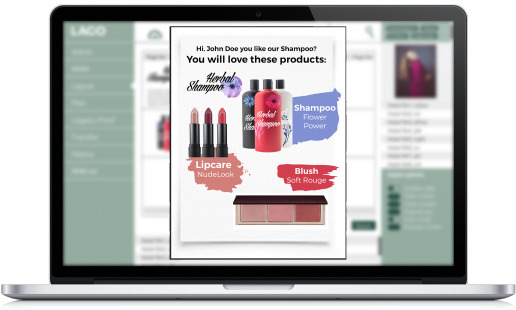Los folletos semanales son los principales impulsores del marketing minorista
Los folletos semanales son los principales impulsores de las decisiones de compra en el sector minorista – cómo la automatización de los procesos de impresión puede ahorrarle dinero en su presupuesto de marketing
Los grandes minoristas se encuentran en medio de una difícil transición. Tras el COVID, la inflación y la crisis de la cadena de suministro, hay que encontrar formas innovadoras para que las marcas tengan éxito. Por ello, la demanda de creatividad nunca ha sido mayor. En este sentido, el folleto semanal sigue siendo la herramienta elegida por muchos grandes minoristas.
Según los datos de la encuesta realizada por Vericast, los folletos semanales siguen siendo una herramienta eficaz para captar a los clientes. Los folletos semanales son un importante motor de ventas: el 66 % de los consumidores estudian los descuentos y las ofertas especiales de un folleto antes de ir a comprar. El estudio también muestra que el 87 % de los compradores lee los folletos durante el mismo tiempo o más que el año anterior.
Una de las razones de la continua popularidad de los folletos y prospectos es su facilidad de lectura. Según Vericast, los materiales impresos, incluidos los folletos enviados por correo, requieren un 21% menos de esfuerzo cognitivo para su lectura que sus homólogos digitales. Así que la pregunta es: ¿por qué los folletos comerciales no están más en el punto de mira de los creativos de marketing?
Una mala reputación inmerecida
Hay varias razones por las que los folletos pueden quedar marginados en el complejo mundo del marketing minorista multicanal. Por un lado, los folletos y los panfletos se comen una parte importante del presupuesto de marketing de un minorista. Parte de ello se debe a factores menos controlables, como el coste del papel y el franqueo, mientras que otros factores, como la mano de obra implicada en la producción, las versiones regionales y la distribución, son sólo aparentemente incontrolables. (La reducción de los presupuestos de marketing ha llevado a algunos minoristas a reducir sus programas de folletos, pero esto ha tenido a menudo consecuencias negativas, como la pérdida de millones de dólares en ventas. Según Vericast, recortar el presupuesto de prospección de comestibles en tan sólo un 5% puede hacer que los resultados se reduzcan debido a la pérdida de ventas que no se pueden recuperar a través de otros medios.
Otro motivo de la inmerecida mala fama del folleto es la supuesta “uniformidad” del formato. Cada folleto contiene una mezcla de muchos productos destacados, ofertas especiales, cupones de descuento y ofertas por tiempo limitado. Una combinación tan compleja requiere mucho trabajo. (Pero como hay que meter tanta información en un número fijo de páginas -y bajo la presión de los plazos-, el diseño tiene que pasar a menudo a un segundo plano. El resultado es muy funcional, como demuestra el impacto duradero de los folletos, pero es difícil producir un diseño que destaque entre la multitud.
Cómo hacer una gran entrada
Resulta que hay una manera de reducir el coste de este valioso medio de marketing y abrir nuevas oportunidades para el diseño creativo: La automatización. Con la estrategia de automatización adecuada, un comercializador creativo puede lograr una mayor eficiencia en los costes y hacer que este importante canal de promoción de la marca del minorista sea más memorable. Es la versión de diseño de “lo mejor de ambos mundos”.
La automatización comienza con la eliminación de las tareas repetitivas relacionadas con los datos que afectan a todas las empresas modernas. Los minoristas suelen tratar con datos procedentes de fuentes de datos fragmentadas, como los sistemas de gestión de información de productos (PIM), los sistemas de gestión de activos digitales (DAM), los sistemas de precios e inventario, los sistemas de gestión de relaciones con los clientes (CRM) y otros sistemas propios. El esfuerzo necesario para crear una campaña de prospección puede ser costoso. Si a ello se añade la necesidad de crear versiones regionales separadas de un prospecto, la automatización puede simplificar radicalmente el proceso.
Afortunadamente, Comosoft LAGO puede hacer precisamente eso. Al vincular todas estas fuentes de datos en un único flujo de trabajo, el proceso de automatización de la producción de marketing de LAGO supera estos retos y facilita tanto la escala como la velocidad, sin comprometer la calidad ni la diversidad de versiones.
La automatización también permite un buen diseño. Cuando se reduce la complejidad de seleccionar y gestionar el volumen de datos de los productos, los diseñadores pueden centrarse en lo que mejor saben hacer: diseñar.
Una vez más, Comosoft LAGO satisface esta necesidad, permitiendo a los directores de marketing y a sus equipos causar una gran impresión. El flujo de trabajo de LAGO conecta múltiples fuentes de datos (especificadas por la dirección de marketing de la empresa) con el pilar del diseño de impresión moderno: Adobe InDesign. De este modo, los folletos y volantes con gran cantidad de datos pueden recibir toda la energía creativa de diseñadores experimentados, incluso cuando se producen varias versiones regionales o demográficas.
El multiverso del marketing
Por supuesto, el folleto es sólo una parte de un número cada vez mayor de canales de marketing, que compiten por la atención de los clientes. Los estudios han demostrado que una campaña coordinada con una mezcla coherente de mensajes y atractivo visual es mucho más eficaz que cualquier componente individual por sí solo. Por eso, cuando la información puede transferirse sin esfuerzo de un medio a otro, se crea un “splash” de marketing que puede suponer un ahorro neto de costes.
Este “splash” es también una ventaja de LAGO. Cuando se prepara un folleto para su impresión, incluyendo varias versiones, los datos e imágenes promocionales pueden exportarse automáticamente a aplicaciones web o móviles, lo que facilita la orquestación de una campaña multicanal contemporánea. En lugar de esforzarse por ejecutar una campaña tan compleja una vez, los equipos de marketing y creativos pueden hacerlo cómodamente cada semana.
En el entorno ferozmente competitivo de hoy en día, el contenido, los activos, los canales y las campañas de un minorista crecen exponencialmente, incluso cuando los recursos y los presupuestos se estancan o disminuyen. Por tanto, la necesidad de causar un gran impacto nunca ha sido mayor. Pero con LAGO, un director creativo o de marketing inteligente puede conseguirlo.
Wochenprospekte als Schlüsselfaktoren im Einzelhandelsmarketing
Wochenprospekte sind die entscheidenden Treiber von Kaufentscheidungen im Einzelhandel – Wie die Automatisierung von Printprozessen dabei Ihr Marketingbudget schont.
Große Einzelhändler befinden sich mitten in einer schwierigen Übergangsphase. Nach COVID, der Inflation und der Lieferkettenkrise müssen innovative Wege gefunden werden, um Marken erfolgreich zu machen. Infolgedessen war die Nachfrage nach Kreativität noch nie so groß wie heute. Der wöchentliche Prospekt ist für viele große Einzelhändler dabei weiterhin ein Mittel der Wahl.
Laut der von Vericast gesammelten Umfragedaten sind Wochenprospekte immer noch ein wirkungsvolles Instrument zur Kundenbindung. Wöchentliche Prospekte sind ein wichtiger Umsatztreiber: 66 % der Verbraucher studieren die Rabatte und Sonderangebote in einem Prospekt, bevor sie einkaufen gehen. Die Studie zeigt auch, dass 87 % der Käufer die Prospekte genauso lange oder länger lesen als im Vorjahr.
Ein Grund für die anhaltende Beliebtheit von Prospekten und Flugblättern ist die leichte Lesbarkeit. Laut Vericast erfordern gedruckte Materialien, einschließlich per Post verschickter Prospekte, 21 % weniger kognitiven Aufwand beim Lesen als ihre digitalen Gegenstücke. Die Frage ist also: Warum stehen Prospekte im Einzelhandel nicht stärker im Fokus der kreativen Marketingleiter?
Ein unverdient schlechter Ruf
Es gibt mehrere Gründe, warum Prospekte in der komplexen Welt des Multichannel-Einzelhandelsmarketings an den Rand gedrängt werden können. Zum einen verschlingen Prospekte und Flyer einen erheblichen Teil des Marketingbudgets eines Einzelhändlers. Ein Teil davon ist auf weniger gut kontrollierbare Faktoren zurückzuführen, wie z. B. die Kosten für Papier und Porto, während andere Faktoren, wie z. B. der Arbeitsaufwand für die Produktion, die regionale Versionierung und die Verteilung, nur scheinbar unkontrollierbar sind. (Dazu später mehr.) Schrumpfende oder eingeschränkte Marketingbudgets haben einige Einzelhändler dazu verleitet, ihre Prospektprogramme zu reduzieren, was oft jedoch negative Folgen hatte, einschließlich Umsatzeinbußen in Millionenhöhe. Laut Vericast kann eine Kürzung des Budgets für Lebensmittelprospekte um nur 5 % dazu führen, dass Ihr Endergebnis aufgrund von Umsatzeinbußen schrumpft, die Sie durch andere Medien nicht wieder wettmachen können.
Ein weiterer Grund für den unverdient schlechten Ruf des Prospekts ist die vermeintliche “Gleichförmigkeit” des Formats. Jedes Flugblatt enthält eine Mischung aus vielen vorgestellten Produkten, Sonderangeboten, Rabattcoupons und zeitlich begrenzten Angeboten. Eine solch komplexe Kombination ist sehr arbeitsintensiv. (Auch dazu später mehr.) Aber weil so viele Informationen auf einer festen Seitenzahl untergebracht werden müssen – und das unter Termindruck –, muss das Design allzu oft in den Hintergrund treten. Die Ergebnisse sind höchst funktional, wie die anhaltende Wirkung von Prospekten beweist, aber es ist schwer, ein Design zu produzieren, das sich von der Masse abhebt.
Wie man einen großen Auftritt hinlegt
Wie sich herausstellt, gibt es einen Weg, die Kosten für dieses wertvolle Marketingmedium zu senken und neue Möglichkeiten für kreatives Design zu eröffnen: Automatisierung. Ein kreativer Marketingleiter kann mit der richtigen Automatisierungsstrategie eine größere Kosteneffizienz erreichen und diesen wichtigen Kanal zur Förderung der Marke des Einzelhändlers einprägsamer gestalten. Es ist die Designversion des „Best of both worlds“.
Die Automatisierung beginnt mit der Beseitigung sich wiederholender datenbezogener Aufgaben, die alle modernen Unternehmen plagen. Einzelhändler haben es oft mit Daten aus fragmentierten Datenquellen zu tun, darunter PIM-Systeme (Product Information Management), DAM-Systeme (Digital Asset Management), Preis- und Bestandssysteme, CRM-Systeme (Customer Relationship Management) und andere proprietäre Systeme. Der Aufwand, der für die Erstellung einer Prospekt-Kampagne erforderlich ist, kann teuer sein. Wenn man dann noch die Notwendigkeit hat, separate, regionale Versionen eines Prospekts zu erstellen, kann die Automatisierung diesen Prozess radikal vereinfachen.
Glücklicherweise kann Comosoft LAGO genau das tun. Durch die Verknüpfung all dieser Datenquellen in einem einzigen Workflow überwindet der LAGO-Prozess zur Automatisierung der Marketingproduktion diese Herausforderungen und erleichtert sowohl die Skalierung als auch die Geschwindigkeit – ohne Kompromisse bei der Qualität oder Versionsvielfalt.
Gutes Design wird auch durch Automatisierung ermöglicht. Wenn die Komplexität bei der Auswahl und Verwaltung der Menge an Produktdaten reduziert wird, können sich Designer auf das konzentrieren, was sie am besten können – Designen.
Auch hier erfüllt Comosoft LAGO diesen Bedarf und gibt den Marketingleitern und ihren Teams die Möglichkeit einen großen Eindruck zu hinterlassen. Der LAGO-Workflow verbindet mehrere Datenquellen (wie von der Marketingleitung des Unternehmens vorgegeben) mit dem Hauptpfeiler des modernen Druckdesigns – Adobe InDesign. Datenintensive Prospekte und Flyer können so die volle kreative Energie von erfahrenen Designern erhalten, selbst wenn mehrere regionale oder demografische Versionen produziert werden.
Das Marketing-Multiversum
Natürlich ist der Prospekt nur ein Teil einer immer größer werdenden Zahl von Marketingkanälen, die alle um die Aufmerksamkeit der Kunden buhlen. Studien haben gezeigt, dass eine koordinierte Kampagne mit einer konsistenten Mischung aus Botschaften und visueller Anziehungskraft weitaus effektiver ist als jede einzelne Komponente für sich genommen. Wenn also Informationen von einem Medium mühelos auf ein anderes übertragen werden können, führt dies zu einem Marketing-“Splash”, der zu Nettokosteneinsparungen führen kann.
Auch dieser “Splash” ist ein Vorteil von LAGO. Wenn ein Prospekt für den Druck vorbereitet wird, einschließlich mehrerer Versionen, können die Werbedaten und das Bildmaterial automatisch in webbasierte oder mobile Apps exportiert werden, so dass es einfach ist, eine zeitgemäße Multichannel-Kampagne zu orchestrieren. Anstatt sich mit der einmaligen Durchführung einer solch komplexen Kampagne abzumühen, können die Marketing- und Kreativteams dies bequem auf wöchentlicher Basis tun.
Im heutigen harten Wettbewerb wachsen die Inhalte, Assets, Kanäle und Kampagnen eines Einzelhändlers exponentiell, auch wenn die Ressourcen und Budgets stagnieren oder sinken. Die Notwendigkeit, eine große Wirkung zu erzielen, war daher noch nie so groß. Aber mit LAGO kann ein versierter Kreativ- oder Marketingdirektor genau das tun.
Weekly brochures as key drivers in retail marketing
Weekly brochures are the key drivers of purchase decisions in the retail – How the print automation saves your marketing budget in the process
Major retailers are in the midst of a difficult transition. After COVID, inflation and the supply chain crisis, innovative ways must be found to make brands successful. As a result, the demand for creativity has never been greater. The weekly prospectus continues to be a tool of choice for many major retailers in this regard.
According to survey data collected by Vericast, weekly leaflets are still an effective tool for customer engagement. Weekly leaflets are an important sales driver: 66% of consumers study the discounts and special offers in a leaflet before they go shopping. The study also shows that 87 % of shoppers read the brochures as long or longer than in the previous year.
One reason for the continued popularity of brochures and leaflets is their ease of reading. According to Vericast, printed materials, including mailed brochures, require 21% less cognitive effort to read than their digital counterparts. So the question is: why aren’t retail brochures more in the focus of creative marketers?
An undeservedly bad reputation
There are several reasons why leaflets can be marginalised in the complex world of multichannel retail marketing. For one, brochures and flyers eat up a significant portion of a retailer’s marketing budget. Some of this is due to less controllable factors, such as the cost of paper and postage, while other factors, such as the labour involved in production, regional versioning and distribution, are only seemingly uncontrollable. (More on this later.) Shrinking or constrained marketing budgets have tempted some retailers to reduce their brochure programmes, but this has often had negative consequences, including millions of dollars in lost sales. According to Vericast, cutting your grocery prospecting budget by as little as 5% can cause your bottom line to shrink due to lost sales that you can’t make up through other media.
Another reason for the undeservedly bad reputation of the leaflet is the supposed “uniformity” of the format. Each leaflet contains a mixture of many featured products, special offers, discount coupons and limited time offers. Such a complex combination is very labour intensive. (More on that later, too.) But because so much information has to be packed onto a fixed number of pages – and under deadline pressure – design too often has to take a back seat. The results are highly functional, as the enduring impact of brochures proves, but it’s hard to produce a design that stands out from the crowd.
How to make a grand entrance
As it turns out, there is a way to reduce the cost of this valuable marketing medium and open up new opportunities for creative design: Automation. With the right automation strategy, a creative marketer can achieve greater cost efficiencies and make this important channel for promoting the retailer’s brand more memorable. It is the design version of the “best of both worlds”.
Automation starts with eliminating repetitive data-related tasks that plague all modern businesses. Retailers often deal with data from fragmented data sources, including product information management (PIM) systems, digital asset management (DAM) systems, pricing and inventory systems, customer relationship management (CRM) systems and other proprietary systems. The effort required to create a prospecting campaign can be expensive. Add to that the need to create separate, regional versions of a prospectus, and automation can radically simplify the process.
Fortunately, Comosoft LAGO can do just that. By linking all these data sources into a single workflow, LAGO’s marketing production automation process overcomes these challenges and facilitates both scale and speed – without compromising quality or version diversity.
Good design is also enabled by automation. When the complexity of selecting and managing the volume of product data is reduced, designers can focus on what they do best – designing.
Again, Comosoft LAGO meets this need, empowering marketing managers and their teams to make a big impression. The LAGO workflow connects multiple data sources (as specified by the company’s marketing management) with the mainstay of modern print design – Adobe InDesign. Data-intensive brochures and flyers can thus receive the full creative energy of experienced designers, even when multiple regional or demographic versions are produced.
The marketing multiverse
Of course, the brochure is just one part of an ever-growing number of marketing channels, all vying for customers’ attention. Studies have shown that a coordinated campaign with a consistent mix of messaging and visual appeal is far more effective than any individual component on its own. So when information can be effortlessly transferred from one medium to another, it creates a marketing “splash” that can lead to net cost savings.
This “splash” is also an advantage of LAGO. When a brochure is prepared for print, including multiple versions, the promotional data and imagery can be automatically exported to web-based or mobile apps, making it easy to orchestrate a contemporary multichannel campaign. Instead of struggling to execute such a complex campaign once, marketing and creative teams can conveniently do so on a weekly basis.
In today’s fiercely competitive environment, a retailer’s content, assets, channels and campaigns are growing exponentially, even as resources and budgets stagnate or decline. The need to make a big impact has therefore never been greater. But with LAGO, a savvy creative or marketing director can do just that.
Successful Omnichannel Content Management with LAGO
Successful Omnichannel Content Management with LAGO
How can you convince a customer to buy a product after they have abandoned their shopping basket? You should reach the customer optimally at every station of their everyday life – the advertising message of your own company should be present to the customer as positively and consistently as possible. Omnichannel is the logical linking of communication channels so that there is no interruption in the flow of information for the customer throughout the entire customer journey. From the company’s point of view, this is how they react to possible customer abandonment – because they cannot (yet) exactly foresee the reason for a possible abandonment, they react on another communication channel in order to retain or even reactivate the customer.
How can Omnichannel Management be successfully implemented?
LAGO is a standard software that has been tried and tested for over 20 years and meets all your requirements for a central system for the production of advertising materials. Thus a smooth, target-oriented and secure implementation is possible. Cross-channel campaigns can be easily planned, allowing LAGO to enable you to do real Omnichannel Marketing. Make your Omnichannel activities faster, safer and more flexible, and drastically reduce costs as a result. Centralized and media-neutral content management eliminates the need for multiple efforts, eliminates sources of error and dramatically shortens time-to-market. Article and price changes in real time allow flexible action on all channels so that your employees can concentrate on their core tasks again.
But Omnichannel Marketing only works perfect, if your content is already prepared and organised for your different marketing channels – LAGO can help you with that. On the basis of the neutral data, you can organise your marketing projects for print, e-commerce, mobile, social commerce and point of sale, link them with each other and output them to the appropriate channels. With LAGO, you receive the right software for managing your product data and thus create an optimal basis for uniform Omnichannel Marketing in the various marketplaces of modern commerce.
You acquire a proven and future-oriented tool with which you can also serve other channels such as mobile commerce or social commerce platforms at a later point in time: Omnichannel!
One-to-one communication in Omnichannel Marketing with LAGO DIM
The additional module DIM – “Direct Individual Marketing” – from LAGO enables you to direct your marketing measures even more specifically towards your customers. After “One-to-Many” or “One-to-Few” has already been covered by LAGO for over 25 years thanks to its unique variant model, LAGO DIM enables you to play out “One-to-One” for both the digital area and the print channel.
With LAGO DIM you can produce personalised and individualised print pages. Various levels of individualisation are available to you. Starting with simple personal salutations including references to individual shop landing pages, through to individual products and prices per customer or customer group.
The same applies to playout in online channels: personalised newsletters and individual e-mail campaigns can be generated from LAGO with little effort using the new DIM module. Cross-channel links from print products to digital channels (print-to-web) generate an ideal interaction of both channels by means of image recognition or QR codes.
As a result, marketing measures can now be targeted even more precisely at the recipients. Respond to the ongoing change in the print and media industry, where it is important to stand out from the flood of advertising with relevant content.
Use the positive effect of personalised and individualised advertising approaches on your sales!
With LAGO DIM everything is possible
- Creation of personalised and individualised print pages based on templates or freely designed individual products
- Use of already designed LAGO documents as the basis for the leap from “One-to-Many” or “One-to-Few” to “One-to-One” by merging existing pages with personalised and individualised offers
- Cross-channel links from the print side to digital channels based on image recognition or QR codes
- Template editor for HTML content
- Generation of personalised and individualised e-mails and landing pages based on product data from LAGO PIM

What is shopping cart abandonment?
In e-commerce, shopping cart abandonment is when a potential customer places a product in the digital shopping cart, but the purchase is not completed by the transaction. The share of shopping cart abandonments in the total transactions of a shop is an important KPI in e-commerce, as it can indicate a non-optimal user experience during the purchase process. The search for a possible cause of shopping cart abandonment is very difficult and usually involves time-consuming tracking. However, there are various omnichannel marketing options to turn shopping cart abandonment into a successful transaction. A common approach in e-commerce, for example, is the remarketing e-mail, which is automatically sent to the shopping cart abandoner and often contains an attractive discount code on the shopping cart value.
Commercial Printing Industry Outlook for 2022
Commercial Printing Industry Outlook for 2022
By 2029, the results of economic, technological, demographic, ecological, and behavioral factors will change the printing industry significantly, according to a 2019 report from Smithers. Almost every industry has faced new challenges since the pandemic and lockdowns occurred in 2020 – the printing industry was no exception. But, as is the case with any industry that wishes to survive as the world evolves, the printing industry has also evolved alongside it to stay relevant and increase revenue.
Let’s Start with Some Statistics
It’s essential to understand the industry’s statistics and forecasts before getting into industry trends. Here are five industry statistics and forecasts to keep in mind:
- 25,000 companies specialize in commercial printing
- Reaching around $139 billion in 2019, digital print output is forecast to grow by 65% over the next 10 years to reach $230 billion by 2029
- 72% of companies use direct mail campaigns
- global digital printing market size was valued at $25.74 billion in 2019, and is projected to reach $35.71 billion by 2028, registering a CAGR of 3.7% from 2021 to 2028
Familiarizing yourself is important because with these statistics, it shows the steady interest and growth potential of commercial printing. Looking at these statistics, it’s also easy to understand why many companies increase their annual print budget.
The Top Trends
The new capabilities in digital printing will enable print suppliers to offer customers greater agility while a number of societal trends will fuel overall digital print growth, according to Smithers. As a result, new products and services arise every year, and keeping up with the latest trends is the ticket to staying ahead of the game. Smithers states:
“The most significant change for digital printing over the next 10 years will be through developments integrating digital print, particularly inkjet, into broader production systems. This includes workflow and finishing to simplify and speed up time to market for many print products”.
But the changes will happen in technical innovations and other top commercial printing trends that are expected to surface throughout 2022.
Design Services
Having a design team is becoming essential for even the smallest printing companies. Whether it’s a single graphic designer or a whole group, focusing on this business area will ensure you stay competitive in the industry. Moreover, instead of solely depending on print income, you can now earn revenue from logo and website design.
Digital Marketing
Digital marketing is one of the most effective forms of marketing available today. One single campaign can potentially reach millions of potential or existing customers. Social media advertisements are a perfect example as they can reach targeted viewers for an indefinite time with one looping piece. Digital marketing is not limited to social media ads, however. It also includes services such as website hosting and podcast creation. As a result, printing companies that utilize these services can substantially grow their business in 2022.
Direct Mail Marketing Campaigns
Direct mail marketing campaigns are widely known as one of the most basic forms of advertising. They are a consistent, effective way to reach new customers while remaining relatively affordable. Direct mail marketing campaigns are a great way to influence current or inactive customers and provide an opportunity for companies to keep their image in the public eye. Direct mail marketing campaigns are expected to rise throughout 2022.
Sustainability Will Have a Higher Priority
Reducing their environmental impact has become a top priority for many organizations, and as such, manufacturers and channel partners must provide more sustainable technology services. Sustainability can be achieved through enhanced data analysis and reporting, circular products and services, carbon data analysis, and process automation. In addition, moving customers from on-premise servers to the cloud can reduce IT consumption of energy and related carbon emissions.
Customization is Key
It comes as no surprise that most customers desire a personalized product. Personalization has taken over the eCommerce industry in this day and age, so the printing industry must adapt to keep up. Corporations should not be afraid to incorporate artificial intelligence (AI) and the Internet of Things (IoT) in the coming years. In fact, by combining the two, you can provide personalization, predict paper usage, and send alerts about possible breaches, making the printing environment efficient and reliable.
The most significant change for digital printing over the next 10 years will be through developments integrating digital print, particularly inkjet, into broader production systems. This includes workflow and finishing to simplify and speed up time to market for many print products. This has already happened in some cases, for example books, where high-speed single-pass inkjet presses are linked to servo-controlled finishing lines that slit, fold and collate book blocks, delivered for loading into a binder. This allows printers to add real value to their publisher customers by helping reduce the publishing risk through delivering lower run lengths cost effectively, down to single copies.
Print catalogues: Why they are irreplaceable for retailers in their marketing mix
Print catalogues: Why they are irreplaceable for retailers in their marketing mix
In the last two decades, marketing has focused primarily on the digital world rather than physical print, but that doesn’t mean print marketing is obsolete. In fact, catalogs are essential for marketing, and studies indicate that they’re more effective than many other forms of advertising.
Now more than ever, catalogs are effective because of technological innovations that enable companies to target customers based on their interests and buying habits. Here are some of the reasons why you need to begin implementing or bolster your current catalog marketing.
Why Print Is Often More Effective Than Digital
Every day, the public is overwhelmed by constant marketing. People see ads on their internet browsers, emails, phone applications, and televisions, and with this constant exposure to digital marketing, people are quick to dismiss ads without paying close attention.
What sets catalogs apart from digital advertisements is that you can’t ignore them in the same way. Instead, a catalog may sit around a consumer’s house for months, creating more awareness for your brand. So even if they make the conscious effort to throw the catalog away, you’ve already reinforced your products and brand multiple times before that occurs – and stimulated future purchases.
The Science Behind Why Catalogs Work
Catalogs are more effective in leaving a psychological impact than digital advertisements. When a consumer flips through a catalog, they’re more likely to imagine themselves possessing a product, which increases their likelihood of making a purchase.
Neuroscience also corroborates that physical ads are often more effective than digital. According to a study conducted by the U.S. Postal Service Office of Inspector General and Temple University, physical advertisements stimulate an area of the brain, which causes potential buyers to consider the product’s value and whether they want it.
Catalogs also stimulate more senses than digital ads. For example, digital advertisements reach consumers on an audial and visual level, but catalogs can be seen, felt, and may even have a subtle print smell. According to USPS and Summit Research, these different senses create more emotional associations, increasing the likelihood that someone will make a purchase.
Additionally, USPS and Summit Research indicated that people are more likely to connect positive emotions to catalogs because people frequently flip through them for entertainment and relaxation. Catalogs even reduce the anxiety associated with receiving a bill in the mail.
Although physical mail has shown to be highly effective in many demographics, they’re especially effective in attracting millennials. The same study conducted by USPS and Summit Research indicated that millennials care more about physical mail than other demographics and are more likely to spend time reading their mail, including catalogs. Millennials are a critical target age demographic, so appealing to them through catalogs is essential.
Catalogs Work Even Better in the Digital Age
One common reason why companies don’t utilize catalogs is the cost of printing and mailing advertisements. However, the digital age has enabled companies to reduce costs associated with sending out catalogs. Before the internet, companies would frequently send out catalogs without a specific target customer in mind, which was particularly expensive because of the large number of prints and their associated mailing expenses.
In the digital age, companies can send targeted catalogs to customers that are more likely to purchase their products. Online databases contain unique consumer information, including their interests and spending habits. Because of this, companies can determine who will be more likely to buy their products and market to them specifically. Additionally, it reduces expenses by avoiding sending catalogs to people who are less likely to make a purchase.
You can even use customers’ past purchases to shape how you market to them going forward. For example, if your company sells many different products and some only buy clothing, you can send out clothing catalogs to that targeted group. Personalized marketing through customer data greatly enhances the likelihood that someone will purchase your products.
Using Catalogs in a Multichannel Marketing Approach
When your business utilizes catalogs in tandem with other marketing channels, you can increase your conversion rate by reaching potential customers in different mediums For example, customers who receive a catalog may be prompted to visit your website and purchase online. You can also track your catalog’s return on investment with mail dates, customer codes, and source codes.
Utilizing catalogs in your multichannel marketing strategy is a highly effective way to reach new customers and engage your existing customer base.
How Automation Makes Print Production Successful
How Automation Makes Print Production Successful
Print is not dead! In a world where the flood of ephemeral online ads is quickly seen and forgotten just as fast, the humble printed catalog or flyer can have a long-lasting effect on the consumer. This is not just a matter of personal preference. A report in Scientific American recently concluded that “reading on paper still boasts unique advantages” over screens.
Suppose a printed catalog is well designed and produced. In that case, it is far more likely to remain on a table or counter, a reminder of the retailer’s brand and an open invitation to browse calmly at one’s leisure. The same cannot be said of an online or email ad, which is swiped aside forever in an instant by the next frantic, on-screen interruption. As publishing pioneer John W. Seybold once said:
“Print speaks to us, quietly and patiently.”
Production depends on various data sources
Catalogs and brochures depend on the correct functioning of some systems and data sources during production, which makes the process prone to errors. Each one is described by a whole table of data. The data include (but are not limited to) the following information on each product:
| SKU number | Manufacturer ID number(s) | Make and model |
| Full product name | Abbreviated name | Short product description |
| Long product description | Version number | Size or dimensions |
| Color(s) | Material specifications | Component parts |
| Relation to other products | Manufacturer | Purchase history |
| Overall inventory quantity | Store location(s) | Warehouse location(s) |
| Projected availability | Item price | Item cost |
| Gross margin | Rebates and discounts | Sale pricing guidelines |
| Product reviews | Marketing campaign history | Shipping information |
| Warranty information | Disclaimers | And more… |
Of course, not all these data points will make it into a catalog or flyer, but many will. The others are all relevant to planning every campaign – AND they are typically scattered across many separate databases. If you multiply all those data points by the sheer volume of individual products advertised, then you’ll get an inkling of the formidable challenges every marketing production manager faces.
Each printed marketing piece includes an array of products selected by the marketing team for their importance to the company’s bottom line. Item pricing strategies offer specials on desirable but price-sensitive items while charging normal prices on other products to make up the difference. Campaigns differ by geographic region and demographics, meaning that each printed piece must have multiple versions. Print versioning makes it even more critical to have a production process that reliably maintains a solid connection to all data sources during the design process.
Automation offers enormous advantages
With so many time-consuming variables, and so many chances to make costly errors, the only solution is to automate the process. As Home Depot, Lowe’s, and other large retailers have learned, there are enormous benefits to automating the print and media marketing process:
- Greatly reduced user intervention at each step in the process, accelerating time-to-market and targeted volume of marketing campaigns
- Greater and more efficient collaboration among siloed departments within a large organization
- Sustained cost savings, among other things due to less cost-intensive error sources through automated correction cycles
- Greater return on marketing campaigns that can be targeted and measured with greater accuracy
Automation applies to everything, from planning the marketing campaign to producing well-designed printed pieces and their umpteen versions. Only by automating the tedious, repetitive tasks can a production team find time to design. Moreover, once tasks become streamlined, other departments are freed to pursue nonroutine tasks, such as SEO strategy and mobile development. Only with a single, controlled chain of events can a marketing production manager and peers survive, and even thrive, in this ever-changing, data-driven world. Here’s how it plays out:
Start with the planning stage. Single product and product line marketing teams spend their time visualizing the next campaign and turning it into practical steps. The goal is to produce an attractive campaign, and track its progress and improve future marketing efforts. Even though they know their products intimately, something is always changing. For example:
- A new version of the product may be imminent.
- The product’s availability, price, or margin may have changed.
- The product’s photos or descriptions may have changed.
- A supply chain problem may affect delivery for some stores.
- A specific color or size may no longer be available.
These and a hundred other changes may affect which products to feature prominently, if at all. However, marketing teams need access to data in real-time and in one place to make the best possible decision.
Visualizing the printed piece is the next step. Using a web-based whiteboarding environment, LAGO also gives marketers the ability to place high-value products where they belong in a catalog or brochure. For any selected product, all the related data is connected. When the marketing team hands the project off to designers, each product “block” automatically connects to the current product data, images, and any other information the designer may need.
Designing and producing the printed piece is equally automated. The designer receives an InDesign template file, automatically including all the marketing team’s decisions. Thanks to a LAGO plugin for Adobe InDesign, the designer is free to do what they do best – create a memorable design concept – without having to hunt down all the related data from various PIM, DAM, and other databases. If any data elements change during the design process, like an updated product image, the layout is updated in real-time until the piece is sent to be printed. For example, if a regional or demographic version is called for, the system maintains all the common elements while allowing the designer to customize the new version.
Review and approval can be a tedious, largely manual process. Fortunately, LAGO also provides a real-time, bi-directional, and auditable process for marketing teams and designers to identify errors, communicate changes, and verify the final layout before printing.
That’s not the end. LAGO is still at work once the catalog or flyer and multiple versions have gone to print. The data for that particular campaign can be automatically exported to online and mobile advertising channels. Also, since the data for each advertised product is automatically tracked, the marketing team can gauge the success of each component to help them plan the next iteration.
The Smell of Success
Automated, integrated, and multichannel campaigns have enormous potential, not just to relieve the burden placed on marketing production managers. They can also increase profitability exponentially. Printed materials play a vital role in that success. In a New York Times article on the resurgence of catalogs, retail strategist Bruce Cohen remarked, “It’s a pronouncement in favor of what all retailers are recognizing – that there are moments when people want to slow down, and there’s still an important place for the catalog.”
Print is not dead. It is alive and effective. Thanks to automation tools like LAGO, that prediction is now a cost-effective reality in a data-driven world.
Ready to see how Comosoft LAGO can automize the marketing efforts for your retail chain?
Why brochures are valuable
Why brochures are valuable and how your retail chain can simplify their production process
Retail chains continue to rely on printed and digital brochures when it comes to distributing their advertising budget, as these are still one of the most valuable and reliable ways to reach consumers.
Why are brochures so valuable for retail chains?
Research shows that weekly circulars are still a key driver of shopping decisions. In fact, according to a Brandspark 2020 U.S. Shopper Study:
- 66% of consumers study circulars, promotions, and discounts before they go shopping
- In 2020, 87% of shoppers read circular the same amount or more than they did in 2019
- 74% of shoppers consulted their grocery print circulars in search of lower-priced specials
According to the September 2020 Shopper Behavior Monitor Survey of 1,000 primary household grocery shoppers:
- 30% of respondents were using digital store sales flyers ad digital coupons even more than they were earlier in the pandemic
- 27% of respondents said they used store sales flyers more often than during the beginning pandemic
- 28% said they were using digital coupons more often
The brochure production process
When it comes to creating the most promotional leaflets, design is crucial. In addition, retailers need to create multiple versions of the brochures. These are additional factors in an already complicated process.
For example, at a large grocery chain, the production process begins with the marketing department, which is in charge of the high-level planning of the circular. Then, category managers locate offers and determine whether an advertisement should be available, globally, nationally, or in a specific region.
Next, the design team lays out the circular, including copy and pricing, to create the regionalized variants from global and national offers. Once complete, the digital files go back to the category managers to review the ads and identify any necessary corrections. The design team implements the corrections and then sends them back to the marketing team for approval.
This entire process can be particularly hectic when creating multiple versions for different regions, languages, and other demographics or if the team needs to pull product assets from various data sources.
Simplifying brochure production
LAGO retail circular production software makes the entire process effortless, from concept to production. Here’s an example of how LAGO can simplify every step of print or online circular creation:
- At the beginning of the process, LAGO Whiteboard helps the marketing department determine how much space to allocate to each page.
- The marketing department can send the page layout to the category managers via the workflow engine. They can use LAGO Whiteboard to search for each offer and then drag and drop it directly on the page.
- At the same time, category management can select whether an offer should be global or local. LAGO's version optimisation automatically synchronises global offers and takes regional differences into account.
- Once planning and version optimisation is complete, LAGO automatically converts the planning into an Adobe InDesign file with its exclusive LAGO Layout InDesign plugin.
- Designers receive a pre-planned InDesign file with all necessary information from the LAGO PIM and DAM, allowing them to create pages more efficiently and avoid errors. Once the layout is complete, a correction document is generated and passed to category management for review via the workflow engine.
- In LAGO's integrated proof module, all correction requests from category management and marketing are noted directly in the proof document and passed back to the design team. The design team can see the desired changes as soon as they open the pages in InDesign and implement the correction requests.
- The implemented corrections are displayed in LAGO Proof via the workflow engine to Marketing and Category Management for checking the executed corrections.
- With a few simple clicks in LAGO Proof, category managers can check all changes made.
- Any price or text updates are automatically imported so that last-minute corrections do not cause unnecessary stress or chaos.
Ready to see how Comosoft LAGO can simplify circular production for your retail chain?
Accelerate the production of brochures and leaflets in InDesign
No Compromise: Accelerate the production of brochures and leaflets in InDesign – WITHOUT sacrificing good design.
Adobe InDesign is undoubtedly the luxury SUV among layout programmes. First released over twenty-three years ago, Adobe’s “Project K2” replaced PageMaker and eventually displaced the then reigning champion QuarkXPress. Today, Adobe InDesign can do practically everything a designer’s heart desires, and thus much more than just design print pages.
This is precisely where the challenge lies. InDesign now offers a very wide range of functions that can turn a simple design into a complex project. This is especially true for data-driven content. This content is a challenge for print designers whose job it is to create visually appealing and accurate material for a retailer’s most important channel – Print.
The Catalog Conundrum
Printed catalogs and circulars are far from being a dying medium. Even formerly digital-only retail marketers are turning to print, according to RetailDive, using paper catalogs “to break through the ‘noise’ of the online world.” Consumers also trust printed catalogs (76%) far more than digital media such as mobile phone ads (39%), according to a MarketingSherpa survey. There are good, scientific reasons for this. When test subjects were exposed to advertising in either digital or printed form, “their brain activity indicated greater subconscious value and desire for products or services advertised in a printed format,” according to a joint USPS/Temple University study.
Brochures contain very detailed product information. This product information ranges from sizes to colours to prices (which vary depending on the version) and a number of other attributes that are contained in a PIM (Product Information Management) database. On top of all this product information, there are large amounts of image data associated with the products, all stored in a Digital Asset Management (DAM) system.
As a result, the designer needs to collate multiple pieces of information for each product in a brochure or leaflet, as specified by marketing, creating a consistent, visually compelling brand experience. Most retailers also need multiple regional versions of each printed copy – and the same content again to populate their shopping apps. Adobe InDesign, as the most widely used layout programme, includes features for a wide variety of layout design areas. Despite the many useful functions that Adobe InDesign offers, the manual effort to create a layout is extremely high; only the connection to a PIM and DAM system creates the greatest possible efficiency.
The Automation Advantage
The solution to this tedious process is to automate repetitive tasks so designers have more time to actually design. Such automation is possible through third-party plug-ins, thanks to InDesign’s architecture. Comosoft has used this environment to develop LAGO Layout, which combines the complex, specialised worlds of PIM and DAM data with the features and design power of InDesign.
LAGO Layout is the answer to inefficient design processes and enables fast, cost-effective, high-quality design and production. It also allows designers to integrate into any process, from campaign planning and data access to proofing, approval and final output, without compromising on good design.
On the surface, LAGO Layout is simply a plugin for InDesign that adds functionality without leaving the designer’s familiar interface. But once installed, LAGO Layout makes many different tasks easier.
- Workflow automation between marketing and design production teams. LAGO users on the marketing side can select the products to promote based on margin, availability, and other factors, using a whiteboarding process. These decisions are automatically conveyed to the design team as InDesign templates. Marketers can even track the results of their original campaign plans.
- Data integration with PIM and DAM systems and the designer allows them to drag-and-drop products and into an InDesign layout. The two-way link remains live and updateable until final output.
- Proofing and approval cycles are easy, automatic, and fully auditable.
- Multiple versions of each piece can be generated and managed efficiently, allowing regional marketing needs to be met while maintaining the retailer’s brand image and data accuracy.
- Digital output for online e-commerce and mobile apps is automatic, ensuring that all retail media channels contain the same content.
Of course, there is a lot more to the plugin and to the LAGO system as a whole. But for the production designer, the main benefit is time. With so much of the busy work on autopilot, the designer now has time to take full advantage of InDesign’s exceptional capabilities – and create print channel content worthy of a retailer’s brand.
In a world of multichannel marketing, print remains at the forefront and the need for compelling visual content has never been greater. Adobe InDesign is the best tool for the job, but it can’t handle all the variables for complex brochures and leaflets on its own. Automating the process streamlines page creation, preserves data accuracy, and ensures consistent branding, while allowing creative flexibility.
Learn more about LAGO Layout, our plugin for Adobe InDesign that will accelerate and automate your entire design and production workflow for circular ads and brochures. Or book a demo to see for yourself.
How retailers are gearing up for growth with a DAM system
How retailers are gearing up for growth with a DAM system
Covid plus the supply chain crisis has put retailers on the ropes. But agile marketing departments and their creative directors, however, have already taken on the challenges of commerce. One of the most important roles in modern retail marketing is played by data – specifically, the data in the digital asset management (DAM) system.
The DAM challenge
These database systems are nothing new in Retail Marketing. DAM has been around for thirty years. However, early systems were complicated and were usually stored on local network servers. Present-day, most DAM systems reside in the cloud or are heading there but pose no fewer challenges for the creative directors. Here are some of the obvious challenges:
- Consistent Usage – According to a McKinsey report, 19 percent of users still spend their working time searching for and collating data! The savings potential through the integration of a good DAM system is very large but is crucially conditioned by consistent keywording of images. This potential can therefore only be fully exploited through consistent use of the DAM by employees.
- Metadata Madness – The key to any database is its metadata – technical and content related image information. Metadata is the basis for making images findable in the DAM.
- Integration – To be efficient, a DAM system must work seamlessly with many other systems, from product information management (PIM) to marketing campaign planning and production. The fact is that most legacy DAM systems do not play well with other systems/applications.
The evolution of new marketing channels and the intense competition for people’s attention have worsened the situation. In a marketing campaign, a picture may be worth a thousand words. However, getting the right version of the right picture, at the right instant in time, and for the right channel is a major challenge. Traditional DAMs cannot do it alone. A DAM must be much more than a filing system and must be consistently integrated into the IT system landscape.
The ever-growing multichannel world dictates that digital assets must be accessible in real-time – all the time. As a result, accurate and dynamic data are more critical than ever. So, having all your assets in one place – and easily accessible to every person and marketing-related system – is vital.
As a recent article in MarTech put it, “Digital asset management can play a vital role in your marketing organisation, unifying online and offline marketing channels and leading to more efficient marketing resource allocation.”
But not all DAMs are the same
Many DAMs exist in a world of their own, designed to meet the needs of one channel or workflow. Traditional DAMs are cumbersome in the extreme when used for other purposes or channels. They are also not always easily accessible across departments or regions. An InDesign user creating a print or online campaign, for example, may have to exit their design software in order to hunt through a DAM manually to find the photo or description of a promoted product. Hoping that they see the most recent version, they then download the file, thereby creating a duplicate and placing it in the layout.
Multiply that scenario by the number of regional variations in a campaign – and the number of media channels involved – and you get a cumbersome process, slow to market and highly subject to human error. It’s every creative director’s nightmare to discover – too late – that a catalog or brochure error caused the company thousands of dollars.
The LAGO DAM solution
But there is a DAM system designed for today’s multichannel marketing world. Comosoft’s LAGO DAM allows marketing departments to consolidate digital asset management into a single, unified repository – distributing assets to team members across the enterprise through a centralised platform.
LAGO’s automation and integration with other product databases assure that the correct version of the asset for a particular channel will be found immediately. In addition, if a new version of the asset is created, it can be automatically updated throughout the campaign.
Creative designers, photographers, and art directors especially benefit from using the LAGO DAM through an Adobe InDesign layout plugin. Allowing the DAM to manage assets in the background automatically will enable them to focus on what they do best – design and collaborate – rather than waste time searching for the right image.
Category- and product managers also benefit greatly from using the LAGO DAM system. Comosoft is highly adept at integrating DAM, PIM, and other critical databases with its expert planning tools, so that each campaign can use just the right products to feature – even if there are multiple regional variations to consider. Furthermore, the marketing manager’s decisions are automatically conveyed to the InDesign user, including product size, type, color, pricing, regional variations, and the myriad of other details that used to make campaign planning so difficult.
Once a campaign is in motion, LAGO data can be automatically exported to websites, mobile apps, or other digital channels – eliminating the manual process that traditional, channel-specific DAMs can impose..
Every creative marketing director understands the necessity and urgency of having a reliable DAM system – one that is integrated with every step in the marketing workflow. LAGO’s DAM solution grows and evolves with the company – and with the ever-changing, multichannel world.
Learn how Comosoft’s LAGO DAM solution can transform your retail marketing workflows and book a personalised demo with our experts.







